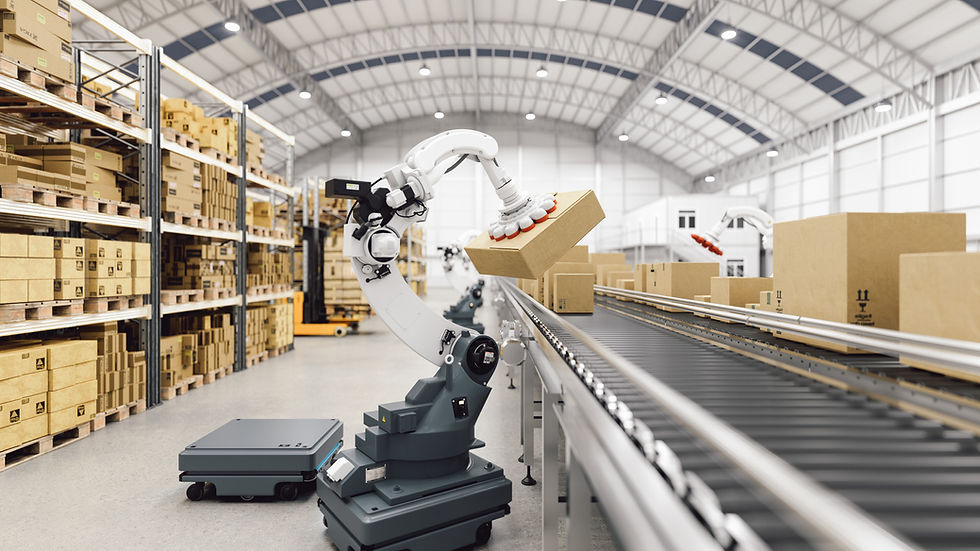How Technology Is Transforming Modern Warehousing
- Carlo Mata
- Mar 18
- 3 min read

In today's fast-paced business environment, technology is not just an option; it’s a necessity for warehouses aiming to thrive. With the rise of e-commerce and consumer expectations for rapid delivery, the need for efficiency and accuracy has never been more crucial. This post will highlight how cutting-edge technologies like automation, data analytics, robotics, and more are reshaping warehousing operations.
Automation and Robotics
Automation and robotics are at the forefront of warehouse transformation. Automated Guided Vehicles (AGVs) and Autonomous Mobile Robots (AMRs) are now common in many storage facilities. In the United States alone, the adoption of robots in warehousing has increased by nearly 20% in the past few years. These machines efficiently transport products from one location to another, which reduces reliance on manual labor.
A prime example can be seen in companies like Amazon, where robotics have helped achieve a 50% increase in operational efficiency. The speed at which these machines navigate the warehouse means faster processing times, ultimately benefiting customers who expect quicker deliveries.
Data Analytics and Inventory Management
Data analytics plays a critical role in modern warehousing. By utilizing advanced data management systems, businesses can maintain better control of inventory. For instance, warehouses leveraging data analytics can reduce inventory holding costs by up to 30%. This happens through real-time tracking of stock levels and demand forecasting, which ultimately helps businesses avoid overstocking or running out of essential items.
A leading example is Walmart, which uses sophisticated data analytics tools to anticipate customer demand. This approach allows them to optimize stock levels and maintain better inventory turnover rates—reportedly achieving turnover that is 10% higher than the industry average.
Internet of Things (IoT)
The Internet of Things (IoT) significantly enhances warehouse operations. By using sensors and smart devices, warehouses can monitor the condition of temperature-sensitive products. For example, a logistics company that utilizes IoT devices has reported a 25% reduction in spoilage of perishable goods due to real-time temperature monitoring.
These devices also assist in accurate inventory tracking, providing precise location data for every item. By integrating IoT with analytics, warehouses can continually improve operations and achieve cost savings through better decision-making.
Warehouse Management Systems (WMS)
A Warehouse Management System (WMS) is vital for modern warehousing. This software enables seamless communication between various technologies used in a warehouse. A well-implemented WMS can lead to a 20% reduction in operational costs through improved inventory accuracy and optimized picking processes.
Companies like Home Depot use advanced WMS solutions to improve their order fulfillment rates. This shift not only enhances operational efficiency but also strengthens customer satisfaction by ensuring on-time deliveries.
Augmented Reality (AR)
Augmented Reality (AR) is changing how workers interact with inventory. With AR devices, employees can receive instant information about product locations through digital overlays. For example, a distribution center using AR has improved picking accuracy by 30%, as workers can visually confirm locations before retrieving items.
AR also aids in the training of new staff. By visualizing processes, new employees can learn faster, reducing the time it takes to reach full productivity by approximately 40%. This effectively shortens training times and enhances overall workforce efficiency.
Cloud Computing
Cloud computing has revolutionized data management in warehouses. By migrating systems to the cloud, facilities can enhance scalability and adapt resources to meet demand. Skyrocketing growth in cloud technology adoption—an estimated 90% of enterprises now use cloud services—highlights its importance.
Cloud solutions also enable real-time data access from any location. For example, organizations utilizing cloud-based inventory systems report a 50% improvement in overall data accessibility, contributing to better decision-making and responsiveness.
Drones in Inventory Management
Drones are increasingly becoming essential for efficient inventory management. These flying devices can conduct inventory scans much faster than traditional methods. For instance, a warehouse recently implemented drone technology and achieved a 30% reduction in inventory auditing time, allowing for more frequent checks.
As a result, employees can redirect their efforts towards tasks that require critical thinking and decision-making, creating a more productive work environment.
Sustainability in Warehousing
Technology is paving the way for sustainable warehousing practices. Energy-efficient technologies, such as smart lighting and HVAC systems, can cut energy consumption by around 40%. One leading retailer, for example, implemented these technologies and reported a 25% decrease in its carbon footprint.
Moreover, automated delivery route optimization can lead to reduced transportation emissions, helping companies meet sustainability goals while still achieving efficiency.
Embracing the Technology Shift
The transformation in modern warehousing is crucial for success in today's competitive market. By adopting technologies like automation, data analytics, IoT, AR, cloud computing, and drones, warehouses can become more efficient, accurate, and sustainable.
Staying informed and adaptable is key as the industry evolves. Emphasizing the right technological advancements will help warehouses not only keep pace but also thrive in the future. The challenge isn’t whether to adopt new technologies; it’s about smartly implementing them for optimal growth and efficiency.
Comentários